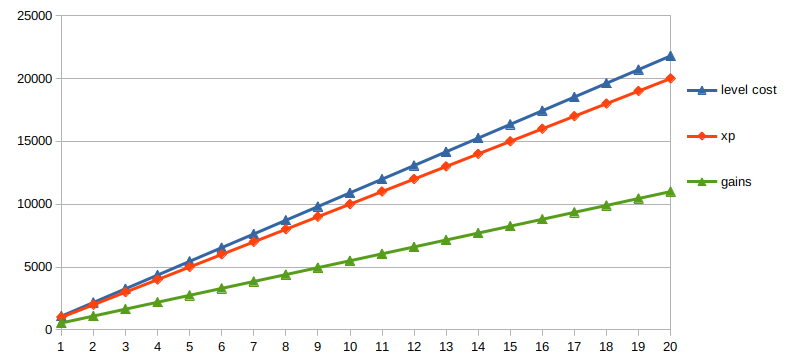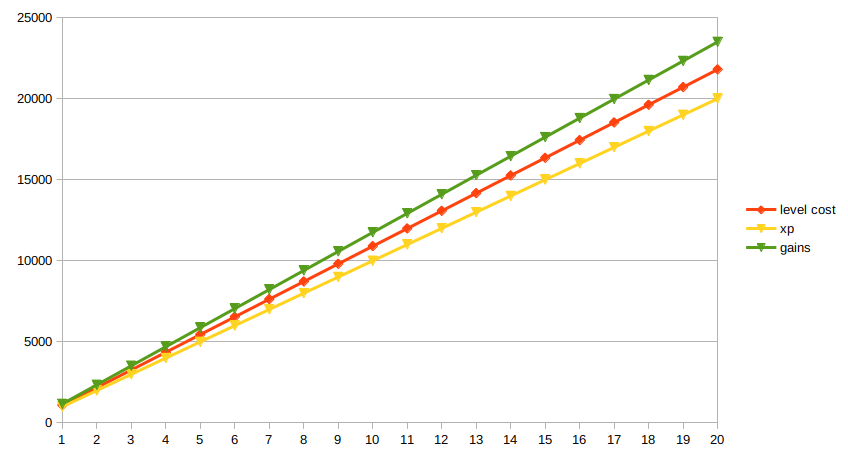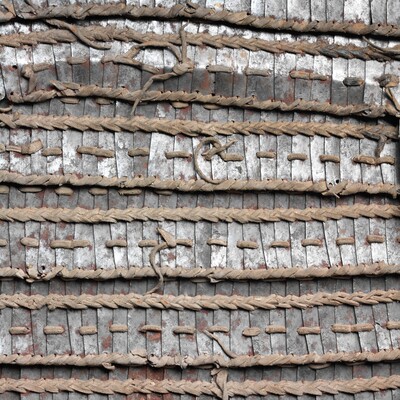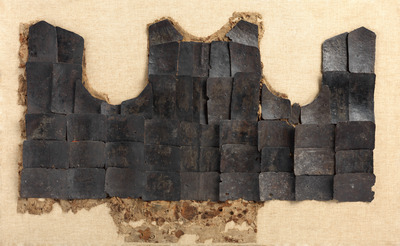The Value of Coin
After the latest round of play-testing, it became apparent that the economic model that I had cobbled together in the initial release is broken. So I've begun to try and figure out the basic coin economy of the game which ultimately will determine how long it takes to gain a new level in TM&R.
Some of the math here is a bit fudged just because I'm guessing at about how many sessions a PC will have at each level. In this I'm going to say three, but that can easily be changed to a different number. So right out of the bag we have a simple 1st to 20th level OSR progression, which following the Knave model means that each level's base cost is L * 1000. In TM&R we have an Upkeep mechanic that requires that the player pays L * 10 coins per week that they were absent from town. Because that absence is determined by a single d6, we can say that an average level upkeep would be something like (((L * 10) * 3) * 3).
The cost to increase to the next level requires the PC to have the XP value in coin (2nd level needs 2000 coin, 3rd needs 3000, etc.) so each level the total cost would be (L * 1000) + (((L * 10) * 3) * 3). This is the amount, roughly, that the PC would need in coin to make it to the next level.
This is where the real question lies. The amount that a PC is able to gain in coin per level needs to be determined. "There lies the rub," as Hamlet put it. Assuming still that we are thinking of roughly 5 scenarios per level, then we can come up with a rough amount of coin that could be gained per session, in this case L * 100. And we can determine the rough amount of other items that might be found in coin value, 500 * L/2. When you graph it all out, it comes out looking like this.

The problem with the graph is that there is a huge margin between the 'level cost' and the 'gains' lines. Although we want to enforce the Debt system built into TM&R, this may make leveling too difficult.
If we change the coin value of items found during a level, however, from (500 * L/2) to (1500 * L/2) then the graph looks more like what a normal RPG economy might. The players can make enough to afford to level, but also need to gain more debt in order to afford anything outside of the normal Upkeep. And while that might be an interesting idea, that isn't what we are going for either.
In real world terms it means that in order to level, or save any money at all after Upkeep an extra session is needed, or a larger gains. So next we'll shift the gains from ((100 * L ) * 3) + (1500 * (L/2)) to ((100 * L ) * 3) + (1750 * (L/2)). Doing so we get this. This is just enough income to see the PCs able to save some coin, or pay for incidental charges from broken gear, while also constantly being threatened with Debt.

This is the table that chart comes from.
| Level | XP | Avg Upkeep | Level Cost | Gains | Difference | Accum. Gains |
| 1 | 1000 | 90 | 1090 | 1050 | 40 | 250 |
| 2 | 2000 | 180 | 2180 | 2100 | 80 | 500 |
| 3 | 3000 | 270 | 3270 | 3150 | 120 | 750 |
| 4 | 4000 | 360 | 4360 | 4200 | 160 | 1000 |
| 5 | 5000 | 450 | 5450 | 5250 | 200 | 1250 |
| 6 | 6000 | 540 | 6540 | 6300 | 240 | 1500 |
| 7 | 7000 | 630 | 7630 | 7350 | 280 | 1750 |
| 8 | 8000 | 720 | 8720 | 8400 | 320 | 2000 |
| 9 | 9000 | 810 | 9810 | 9450 | 360 | 2250 |
| 10 | 10000 | 900 | 10900 | 10500 | 400 | 2500 |
| 11 | 11000 | 990 | 11990 | 11550 | 440 | 2750 |
| 12 | 12000 | 1080 | 13080 | 12600 | 480 | 3000 |
| 13 | 13000 | 1170 | 14170 | 13650 | 520 | 3250 |
| 14 | 14000 | 1260 | 15260 | 14700 | 560 | 3500 |
| 15 | 15000 | 1350 | 16350 | 15750 | 600 | 3750 |
| 16 | 16000 | 1440 | 17440 | 16800 | 640 | 4000 |
| 17 | 17000 | 1530 | 18530 | 17850 | 680 | 4250 |
| 18 | 18000 | 1620 | 19620 | 18900 | 720 | 4500 |
| 19 | 19000 | 1710 | 20710 | 19950 | 760 | 4750 |
| 20 | 20000 | 1800 | 21800 | 21000 | 800 | 5000 |
The data also lets us see roughly how much a PC will be able to save per session, which will come in very handy in just a few minutes.
Now to apply this scale across the board, we have to extrapolate some data by first setting some data. For instance, I don't think that PCs should have access to Full Plate armor until they are at level 10. There is no discernible reasoning for this aside from the fact that at 10th level the PCs will have attained their last Talent, and it just feels right. As it stands right now full plate costs 8000 coins which means that a PC playing 3 sessions per level will never have enough to buy it with their meager savings if they are paying their Upkeep as well. Honestly, that's fine, it just means that more sessions are going to be needed to level. But, it would cost as much as it does to attain 8th level (8720 coins) which sounds like a lot. But it means that at 10th level a character would need a single extra session (an additional 10900 coins) to be able to afford it. It also means that a 7th level character would be able to afford Full Plate with an extra session, something I didn't want to make possible.
So this means that the price of Full Plate is increasing to 11,000 coins. Other prices can be extrapolated from there. Half Plate which had been half the price of full is now 75% the price of full and is 8250 coins, Chain is 20% & 2200, etc.
| Armor | Cost |
|---|---|
| Shield | 80 |
| Shield, Large | 110 |
| Helmet | 275 |
| Leather or Padded | 825 |
| Brigandine or Lamellar | 1100 |
| Chain | 2200 |
| Half Plate | 8250 |
| Full Plate | 11000 |
Knave's idea of low-cost weapons does not seem to work into the idea of armor being so expensive. Why would Lamellar armor cost 1100 coins while a sword only costs 60 which is the same amount as Leather armor? Let's assume that the increase is partly because of quantity of steel, but also because of labor. We know that the leather-worker is making nothing to be able to sell armor at 60, so it has to be with the metal. The math we did above goes a long way to balance this out. Now, Brigandine and Leather armor are very close in price (Leather is 75% the price) and the difference of 275 is the addition of steel plates that the leather-worker is adding in.
Which brings us to the Sword, humble weapon of the knight. But in TM&R, like Knave, we are concerned with the entire d6-class of weapons, ergo the spear, sword, mace, axe, flail, etc. In my complete and utter guesstimation of the amount of metal used in the construction of a sword, is roughly similar to that needed to construct a lamellar armor. I could be way off the mark here, but a stack of thin metal plates seems like they could be about the size of a single ingot used to make a sword, or at least for our purposes it's close enough.
Here is Brigandine armor so you can see the same basic theory is in play with them both, small plates woven together with leather or cord.
Again, if the difference between Leather or Brigandine and Leather is predominantly the metal, whether it is because of the material or labor is inconsequential to us now, that 275 coins should at the very least be the cost of the raw material for a sword. I would also suggest that the creation of a sword is more complicated and requires a fair bit more skill than what is required to make thin plates of metal with holes punched in it. Therefore if 275 is a base, it seems like 1000 coins is a fair representation of what a sword should cost, or an increase of 3.6364 times.
Immediately, however, this brings up the issue of Spears. Spears are notoriously cheap to make, and are common to the majority of fighting men, while the sword is the pièce de résistance of a knight's weaponry. So our simple Knave style weapon chart is going to have to be further complicated. (Someone out there is griping about the possibility of having a poorly made weapon as well, and I hear you. But remember that the Quality rating for a weapon is a thing, and final price could, and should, be adjusted by that as well.) Other games have tackled this issue by having a "Simple Weapons" & "Martial Weapons" charts to separate them. That might be the best option here as well. But let's explore the idea of something different first.
With TM&R we are trying to find a balance between the simplicity of a system like Knave, and the complexity of something like AD&D, well maybe not that complicated so let's say OD&D for argument's sake. We could expound on the Quality system and assign a particular rating for each weapon type. Then each individual weapon would be priced based upon the quality of the piece made. A poorly made sword costs much less than a finely made one. The problem with that comes to damage. If it is going to cost five times as much, it had better do more damage on a hit. But again, in the Knave model weapons do a die's worth of damage, and as of now at least the only thing that changes that in TM&R are certain Talents & Magical Weapons. You could also improve the amount of space the weapon uses in Inventory, but I'm not sure really how to condense the size of a halderd that makes any sort of sense.
This lead me to a sort of solution here. We could use the standard sword as a base amount, and the addition of a +1 or +2 Magical bonus as an increase to the weapons quality itself, not just accounting for the fact that it is magical. This hand-waves the issue which is completely fine in the
If we take the 275 coins for the raw material for a sword and double it, for increased specialized labor and material, we have 550 coins and the cost of a sword. Using the current Magic Weapons table we can make that a Sword +1 and increase the cost to 5500 which is way too much. So let's change the base Magic Weapon +1 modifier to x3, that makes a sword which normally costs 550 coins now cost 1650 coins, which makes sense. It is even easily purchasable at level 3 if a PC really anted to. Now to extrapolate the rest of that table we end up with this.
| Magic Weapon Modifier | Quality Modifier | Cost Multiplier |
|---|---|---|
| +1 | +1 | x3 |
| +2 | +1 | x4 |
| +3 | +2 | X5 |
| +4 | +2 | x6 |
| +5 | +3 | x7 |
| +6 | +3 | x8 |
| etc. | etc. | etc. |
But we cannot forget that we are paying for a damage die as well, more so than an economic placement. And while the changes to the Magical Weapon Chart is fine, I don't think that increases the cost of a sword will work at the table as well. It is likely going to send the players into a debt-spiral that will seem more like work than fun. We want them to be pressured by the debt, but not always ready to commit seppuku at the first broken sword. So while the idea of 550 for a base sword makes sense economically, in game terms it maybe too much. This is going to have to get play-tested further to determine definitively.
Now we are still left with the issue of the price of a sword versus a spear. And the only way around it that I can see if to separate Simple Weapons from Martial Weapons. The difference in price between the Simple d8 weapon and the Martial d8 weapon has to be minimal, else no one would use a Martial Weapon and the world would be populated with Axes & spears, leaving swords as some sort of status system that only the most dedicated socialite or noble could afford. Yeah, I actually like that. We could even go full into this by changing the Character Creation Rules to allow one free simple weapon, instead of any weapon on your choice. And we can reduce the Quality rating of all simple weapons to 2 to further goad PCs into going for the Martial Weapon class.
This leaves us with three weapons table, well two tables for weapons and one for ammunition. There is a glaring exception on the Simple Weapons chart, however.
| Simple Weapons | Cost |
|---|---|
| Knife, Cudgel, Staff, etc. (d6 damage, 1 slot, 1 hand, 1 quality) | 15 |
| Cleaver, Sickle, Ice Pick, etc. (d6 damage, 1 slot, 1 hand, 1 quality) | 25 |
| Spear, Mace, Axe, etc. (d8 damage, 2 slots, 1 hand, 2 quality) | 100 |
| Scythe, Bill, etc. (d10 damage, 3 slots, 2 hands, 2 quality) | 200 |
| Sling (d4 damage, 1 slot, 1 hand, 3 quality) | 15 |
| Bow (d6 damage, 2 slots, 2 hands, 3 quality) | 100 |
| Martial Weapons | Cost |
|---|---|
| Dagger, Kukri, etc. (d6 damage, 1 slot, 1 hand, 3 quality) | 150 |
| Sword, Flail, etc. (d8 damage, 2 slots, 1 hand, 3 quality) | 550 |
| Halberd, Long Sword, Battle Axe, War Hammer, etc. (d10 damage, 3 slots, 2 hands, 3 quality) | 750 |
| Crossbow (d8 damage, 3 slots, 2 hands, 3 quality) | 600 |
"Why do bows & slings get 3 Quality and are still on the Simple Weapons table?" Because Bows in Knave were a little down-played. It was a weapon that took three entire Inventory Slots, two for the weapon and one for the bow, while only dealing 1d6 of damage. In theory it sounds right, but in practice, players are just as likely to ignore the bow because it isn't worth it. Now, however, it might costs three slots and do 1d6 damage, but anyone can get it at Character Creation, and it is cheap.
From this we can start looking at the prices of Tools, most of which are surprisingly in line with the economics of things already. I'm not going to bore you with every change, but instead only mention the places where significant differences were made.
Ships and Henchmen we need to take a closer look, because it doesn't seem to work anymore. A sloop costs 5,000 coins, or 3,000 less than Half Plate. A price of 15,000 sounds more reasonable, this is a rigged sailing vessel big enough to launch raids from or fish from for profit. I doubt the concept of pleasure sailing is a thing that any but nobles would be able to even contemplate. There is a "fishing boat" that costs 500, I'm imagining a small wide-bottom vessel, perhaps square or lateen rigged for about 5,000 coins. It seems that Knave is roughly following their own advice of 480 coins per ton (24,000 for a 50 ton caravel and that's close enough). But the pricing is still far too low. I imagine 1500 per ton at Good Quality is a better price. That puts a Caravel at 75,000 coins which just sounds much better. I'm going to remove the Galleon from the list as I just don't see a 17th century ship in this world.
| Item | Cost |
|---|---|
| Ship, high quality | 3000/ton |
| Ship, good quality | 1500/ton |
| Ship, used quality | 1000/ton |
| Ship, poor quality | 700/ton |
| Raft | 50 |
| Fishing boat | 5000 |
| Sloop | 15,000 |
| Caravel | 75,000 |
Henchmen are assumed to be at 1HD so a man-at-arms on foot should expect to make his upkeep plus enough to profit from to have them stay loyal enough not to leave during combat. Six coins per day or 42 coins a week seems exceptionally low at first glance, but that is a profit of 32 coins per week. If we also add the rule that this rate is also per Hit Die (HD) then this becomes more plausible. A higher HD craftsmen would warrant a higher pay and perform with more skill, allowing them to roll their HD as a modifier.
The rest of the standard Knave costs can be gone through with only minor tweaking now. One of the last big ones left is Jewelry, which I implemented as a consequence of creating the Magical Items section. The idea was to allow for some variance in price for the jewelry. Currently I am multiplying the jewelry's base price roll times 100, and I believe that is too high after some play-testing. Instead I think that it can simply be lowered to x10 and adjusting the dice values of some of the more expensive items.
| Item | Cost x 10 |
|---|---|
| Amulet | 2d8 + 25 |
| Arm-ring | 2d4 |
| Bracelet | 2d6 |
| Brooch | 2d8 |
| Crown | 4d20 + 100 |
| Idol | 3d6 + 10 |
| Necklace | 2d10 |
| Ring | 1d10 |
| Sceptre | 4d20 + 150 |
| Toe Ring | 1d4 |
If you lasted this long you deserve a cookie! I have to give props to my good friend Matt for the initial math that I ran with. Any mistakes are entirely my own, however! I can assume there is a better way of doing this, but I'm not sure what it is, and to be fair this was a fun thought experiment if nothing else. The bonus is that at first glance it appears that the economy of the game is going to be more balanced that before, but only play-testing will prove that without a doubt.
Get Through Muck & Ruin
Through Muck & Ruin
A slightly crunchier OSR TTRPG based on Knave and others.
| Status | In development |
| Category | Physical game |
| Author | Murph |
| Genre | Role Playing |
| Tags | Fantasy, knave, OSR, Tabletop role-playing game |
More posts
- TM&R .87 Released!Mar 11, 2022
- New Cover!Feb 27, 2022
- New Version .75 Released!Jan 27, 2022
- First ReleaseJan 11, 2022


Leave a comment
Log in with itch.io to leave a comment.